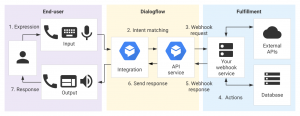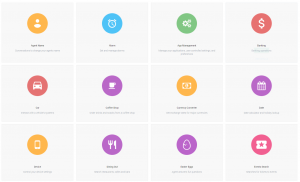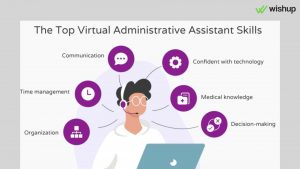
Harnessing the Power of Artificial Intelligence
Artificial Intelligence (AI) has emerged as a transformative force, revolutionizing numerous industries and significantly impacting our daily lives. From advanced algorithms to machine learning techniques, AI offers many benefits and has proven to be a massive improvement across various domains. This essay explores why using AI represents a significant technological leap forward and its wide-ranging positive impacts.
Virtual assistants have emerged as indispensable tools in an era driven by technological advancements, revolutionizing how we interact with technology. From simple voice-activated commands to complex task automation, virtual assistants have become integral to our daily lives, assisting us in various aspects. This essay explores the concept of virtual assistants, their evolution, their impact on society, and their potential for the future.
The Evolution of Virtual Assistants

Virtual assistants have come a long way since their inception. Initially, they were basic programs designed to respond to voice commands and perform simple tasks. However, advancements in artificial intelligence and natural language processing have allowed virtual assistants to understand human speech better, interpret context, and provide more accurate and relevant responses. Today’s virtual assistants, such as Siri, Alexa, and Google Assistant, can handle complex tasks, engage in conversations, and anticipate user needs.
The Functions and Capabilities of Virtual Assistants
Digital agents, virtual assistants, or chatbots have fundamentally transformed how we interact with applications. These intelligent software entities use natural language processing (NLP), machine learning, and artificial intelligence (AI) to understand and respond to user inputs. Here’s how digital agents have reshaped our interaction with applications:
Information Retrieval
AI algorithms have the unique ability to learn and improve over time. Through techniques like machine learning and deep learning, AI systems can analyze feedback, adapt their models, and enhance their performance based on new data and experiences. This iterative learning process enables AI systems to become more accurate, efficient, and effective over time, further contributing to their massive improvement potential.
Task Automation
One of the key advantages of AI is its ability to automate mundane and repetitive tasks. By leveraging machine learning algorithms and cognitive technologies, AI systems can perform complex calculations, data analysis, and decision-making processes at a speed and accuracy far beyond human capabilities. This leads to increased efficiency, reduced errors, and enables individuals to focus on more strategic and creative endeavors, ultimately boosting productivity across industries.
Smart Home Integration
With the rise of Internet of Things (IoT) devices, virtual assistants can control and manage connected smart home devices. Virtual assistants provide a seamless way to interact with our living spaces, from adjusting thermostats to turning on lights.
Personalized Recommendations
By analyzing user preferences and behavior, virtual assistants can offer tailored recommendations for activities like music, movies, shopping, or travel. This enhances the user experience and creates a sense of personalization.
Improved Decision-Making
AI-driven systems excel at processing and analyzing vast amounts of data from diverse sources in real time. This empowers businesses and organizations to make more informed and data-driven decisions. AI algorithms can uncover patterns, correlations, and insights that might elude human analysts, enabling accurate predictions and facilitating proactive decision-making. From finance and healthcare to marketing and logistics, AI-powered decision support systems have the potential to revolutionize industries and drive better outcomes.
The Future of Virtual Assistants
Looking ahead, virtual assistants hold tremendous potential for further transformation. Here are some possible future developments:
Enhanced Personalization
Virtual assistants will continue to refine their understanding of user preferences, enabling even more personalized and context-aware experiences. They will anticipate needs, proactively offer suggestions, and seamlessly integrate into users’ daily routines.
Improved Emotional Intelligence
Advancements in natural language processing and emotional intelligence algorithms will enable virtual assistants to recognize and respond to users’ emotions more accurately. This could lead to more empathetic and human-like interactions.
Multi-Modal Interfaces
Virtual assistants will evolve beyond voice-only interactions and incorporate other senses like vision and touch. Integration with augmented reality (AR) or virtual reality (VR) could enhance their capabilities further.
Collaboration and Integration
Virtual assistants may become more collaborative, working together to perform complex tasks or provide comprehensive support across multiple devices. Integration with other technologies, such as robotics or autonomous vehicles, could open up new possibilities.
Unleashing the Power of Conversational AI: Exploring Dialogflow

In the digital transformation era, businesses constantly seek innovative ways to engage with customers. One technology that has gained significant attention in recent years is conversational AI, and at the forefront of this revolution is Dialogflow. Developed by Google, Dialogflow is a powerful and versatile platform that enables developers to build interactive and intelligent chatbots, virtual assistants, and voice interfaces. This essay delves into the world of Dialogflow, exploring its capabilities, benefits, and the impact it has had on various industries.
Understanding Dialogflow
Dialogflow is a cloud-based platform that leverages natural language processing (NLP) and machine learning algorithms to create conversational agents. It allows developers to design and build chatbots that can interact with users through various channels, such as websites, mobile applications, messaging platforms, voice assistants, and more. Dialogflow’s core strength lies in its ability to understand and interpret human language, enabling dynamic and context-aware conversations with users.
Key Features

Data Flow Diagram
Natural Language Understanding (NLU): Dialogflow’s NLU engine can analyze user inputs, extract important entities and intents, and generate appropriate responses. It can handle complex sentence structures, account for variations in user queries, and provide accurate interpretations.
Intent Mapping and Fulfillment: Dialogflow enables developers to define intents representing the purpose or goal of a user’s message. Intents are mapped to predefined actions or responses, allowing the chatbot to provide relevant and helpful information. Developers can also integrate Dialogflow with external systems to fulfill specific tasks or retrieve data.
Context Management: Dialogflow’s context management system enables the chatbot to maintain context and remember information from previous interactions. This allows for more natural and meaningful conversations, where the chatbot can reference past exchanges and provide personalized responses.
Multilingual Support: With support for over 20 languages, Dialogflow caters to a global audience. Developers can create chatbots that understand and respond in multiple languages, expanding their reach and ensuring a seamless user experience across diverse regions.
Applications across Industries
Customer Support
Chatbots powered by Dialogflow can handle customer inquiries, provide product information, assist with troubleshooting, and even facilitate transactions.
E-commerce
Dialogflow enables personalized product recommendations, order tracking, and seamless shopping experiences, increasing sales and customer retention.
Healthcare
Dialogflow-based virtual assistants can help users book appointments, answer medical queries, provide health tips, and offer medication reminders.
Travel and Hospitality
Chatbots built with Dialogflow can assist with travel bookings, provide destination information, suggest itineraries, and handle customer feedback.

These are pre-built, customizable agents that specialize in different areas of knowledge.
Dialogflow Fulfillment is a powerful tool that enhances the capabilities of the Dialogflow conversational platform. It allows developers to build dynamic and interactive conversational experiences by integrating external systems and services into their chatbots or virtual assistants. With Dialogflow Fulfillment, you can define custom logic and actions triggered based on user input or specific intents recognized by Dialogflow. You can create intelligent responses, fetch data from databases or APIs, perform calculations, and execute various real-time operations.
Dialogflow Fulfillment enables seamless communication between your conversational agent and external services by leveraging webhooks. It supports integration with popular development frameworks, making connecting with backend systems and deploying your fulfillment logic easy.
Whether you need to retrieve information from a CRM, process payments, fetch real-time data, or perform any other custom functionality, Dialogflow Fulfillment provides the necessary tools and flexibility to accomplish these tasks. It empowers developers to create rich, personalized conversational experiences beyond simple text-based interactions.
Overall, Dialogflow Fulfillment bridges the user’s queries and the fulfillment of those queries by integrating external services, making chatbots and virtual assistants more intelligent, interactive, and capable of delivering valuable results to users.
Natural Language Processing (NLP) involves a series of phases or steps to process and analyze human language data. These phases help understand, interpret, and generate natural language text or speech. While different approaches may have variations, the general NLP phases are as follows:
Text Acquisition: In this phase, the raw text or speech data is collected or obtained from various sources, such as documents, websites, social media, or audio recordings. Text acquisition can involve web scraping, data extraction, or other methods to gather the required data for analysis.
Tokenization: Tokenization is breaking down the text into smaller units called tokens. Depending on the requirements, tokens can be words, sentences, or subword units. This phase helps in segmenting the text for further analysis and processing.
Text Cleaning and Normalization: In this phase, the text is preprocessed to remove noise and irrelevant information. It involves tasks like removing punctuation, converting text to lowercase, handling contractions, expanding abbreviations, removing stop words (commonly occurring words with little semantic value), and applying techniques like stemming or lemmatization to reduce words to their base or root form.
Part-of-Speech (POS) Tagging: POS tagging involves assigning grammatical tags to each word in a text based on its role in the sentence. This phase helps identify the part of speech of each word (e.g., noun, verb, adjective) and their relationships, which is crucial for understanding the syntactic structure of the text.
Named Entity Recognition (NER): NER identifies and classifies named entities within the text, such as names of persons, organizations, locations, dates, or other specific entities. It helps in extracting and categorizing important information from the text.
Parsing and Syntactic Analysis: Parsing involves analyzing the grammatical structure of sentences to understand their syntactic relationships. It involves tasks like dependency parsing or constituency parsing, which create parse trees to represent the structure of sentences. This phase helps in understanding the grammatical rules and relationships between words.
Semantic Analysis: Semantic analysis aims to derive the meaning of the text beyond its syntactic structure. It involves tasks like word sense disambiguation, semantic role labeling, or semantic parsing. This phase helps in understanding the intended meaning and context of the text.
Disambiguation and Coreference Resolution: Ambiguities in language, such as pronoun references or word senses, can lead to confusion. Disambiguation and coreference resolution aim to resolve these ambiguities by identifying the referents of pronouns or disambiguating word senses to improve the overall understanding of the text.
Sentiment Analysis: Sentiment analysis focuses on determining the sentiment or opinion expressed in the text, whether positive, negative, or neutral. This phase often involves machine learning techniques to classify the sentiment of the text.
Text Generation and Summarization: In this phase, NLP models can be used to generate natural language text or create summaries of longer documents. Text generation can involve tasks like language translation, chatbot responses, or creative writing based on given prompts.
These phases represent a general overview of the NLP pipeline, and specific applications or tasks may involve variations or additional steps depending on the goals and requirements of the project.
Conclusion
Virtual assistants have revolutionized our interactions with technology, offering convenience, efficiency, and personalized experiences. Their evolution has significantly impacted society, transforming communication patterns and enabling greater accessibility. As we look toward the future, virtual assistants are poised to become even more intelligent and integrated, enhancing our lives in ways we have yet to fully imagine. With ongoing advancements, virtual assistants will continue to shape our relationship with technology, making it more seamless and intuitive.
The utilization of AI represents a significant leap forward in technology due to its ability to enhance efficiency, automate tasks, improve decision-making, personalize user experiences, advance problem-solving capabilities, improve safety and risk management, and enable continuous learning. As AI continues to evolve and expand its reach across various industries, it has the potential to revolutionize countless aspects of our lives. However, it is essential to ensure responsible and ethical use of AI to maximize its benefits while addressing potential challenges. The future holds immense potential for AI-driven advancements, and embracing this technology can lead to a brighter and more innovative world.


Bogdan Anton
Software Developer at RIA Solutions Group


